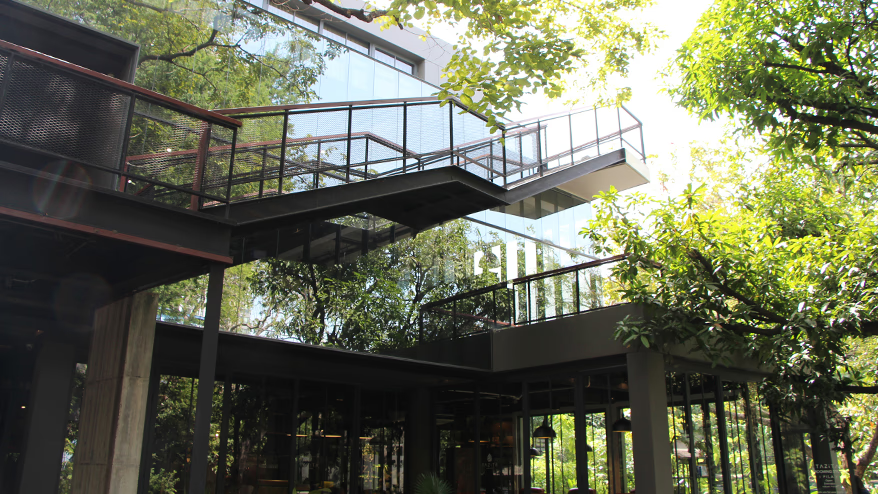こんにちは。モノサスタイランドの町山です。
突然ですが、みなさんはどんなお家に住んでいますか?
物が少なく掃除の行き届いたミニマリストのお部屋。お洋服が大好きで部屋全体が古着ショップのようになっているお部屋。築何年にもなる木造の趣深い庭付き一軒家…。存在する人の数だけ、空間とそこでの暮らしがある。
今回は、タイで暮らす中で気付いた空間の捉え方と暮らしの感覚についてお話したいと思います。
建物から膨らむ暮らしの夢
小さい頃、新聞紙に挟まれた大量のチラシの中から、おもしろそうなチラシだけをいる いらない いる いる…という具合に仕分けしていき、晴れて ”いる” に選別されたチラシだけを一枚一枚じっくりと眺めていくのが好きでした。中でもお気に入りだったのは、建物の図面が載ったチラシ。
この話を、あーわたしも!と思われた方も多いのではないかと思います。
建物のチラシを眺めて一体何をするのかというと、いわずもがな、妄想です。このチラシに描かれているお家にもし住めたなら…リビングはもっとゆったりとしていて、大きなテレビを置いて、ベッドを置いてもまだまだゆとりのある自分の部屋があって…等々。基本的に想像されるのは、現状叶えられていない理想の生活が、その家に引越すことで叶えられるのではないか、という幻想。現状に対する不満が解消された、理想の生活をそのチラシに書かれた図面に反映させて楽しんでいたのです。
わたしは東京で生まれ育ったため、タイに来るまで実家を出たことがありませんでした。実家が引っ越しをしたこともなく、小さな頃から引っ越しをする友達が羨ましかった記憶があります。住む空間を変えるということが、ほぼイコール暮らしぶりを変えることなのだと考えていたのでしょう。その考えは大きくなっても変わらず、同じような考えを持ち続けている人は多いような気がします。はたして、実際に住む場所を変えれば暮らしぶりも変わるものなのでしょうか。
タイで感じる、ウチとソトの感覚
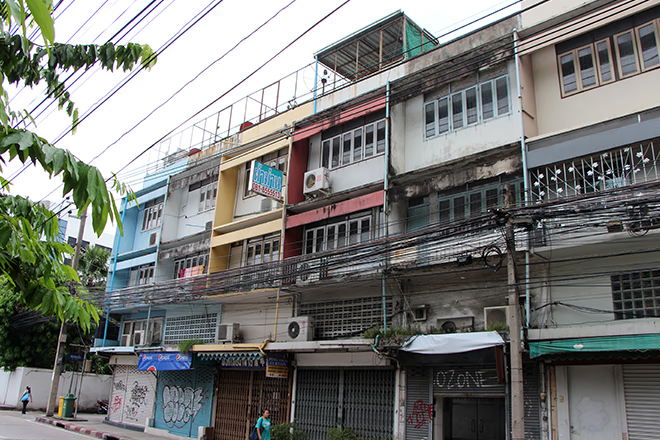
1階がお店、2階から上が居住スペースというタイプの家をよく見かける
「暮らしぶり」とは、日々の生活の仕方であり、生活態度であり、暮らしの中で大切にしていること、その人の価値観も含まれる言葉だと思います。
文化が違えば、普段の生活の仕方も異なり、その根底にある基本的な性格・性質も異なります。
タイ人の根底にある性格についてよく思うのは、あまり壁を作らないということ。ジェンダーの壁にしてもそうかもしれませんが、人との間の壁がそこまでないというか、見知らぬ人に対する壁をそんなに作らないし、日本人よりずっと人と人との距離が近いように感じます。例えばバスターミナルにいると、「どこに行くの?」とそのへんのおばちゃんやおじさんが話しかけてくれて迷わないように最後まで親切に教えてくれます。また、食べ物をとにかくよくシェアしてくれます。タイ人のスタッフの子たちはお菓子を食べるとき、ほぼ必ずみんなに配ります。そのためにわざわざデスクまで来てくれます。スタッフの子はまだわかるのですが、バス停の待合所でグミを食べていたらそれちょうだいと見知らぬタイ人が声を掛けてきたり、ギャラリーの展示に行ったときに近くに座っていた子がおもむろにお菓子を分けてくれたり、本当に垣根がないなと感じます。この感覚は人に対してだけではなく、あらゆる方面に表れていると感じます。
例えば格好について。仕事のときの格好が決まっている職種の人たちが、バイトやおそらく社員の人も含め、勤め先の制服を家から着て通っている人がとても多いのです。高級デパートの店員さんも同様です。デパートの名前が胸元に刺繍されている制服なので、どこで働いているのか見れば一目でわかります。日本人だと働いているとき以外は一個人のプライベートな時間という意識が強いので、どこで働いているかわかるような制服を着ることはまずない気がします。
そして、空間に対しての認識にもその違いが表れます。例えば建物の隅の方で、地べたに座っている人を結構目にします。それは生活のために長時間一定の場所に座って稼いでいる人とはまた別で、仕事の合間に休憩したり、暇をつぶしたり。日本人は外は座ると汚い、と感じる人が多そうですが、そういう感覚が日本人ほどは強くないからかなと思います。
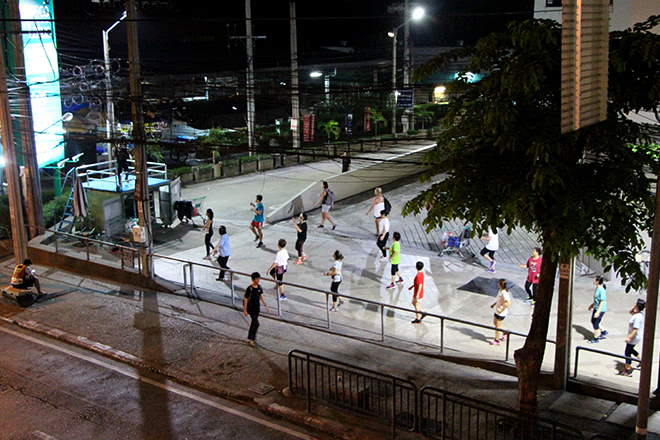
家のすぐ近くのスーパー脇のスペースで毎週金曜に大音量で行われるエクササイズ
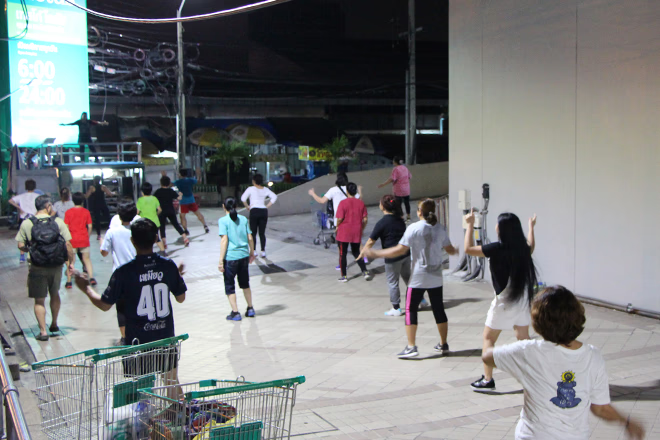
特別イケイケな感じではなく、ごく普通のテンションの人々が参加している。通行人の目は全く気にならない様子
また、最近はコンドミニアムがものすごい勢いで沢山作られていますが、新しい建物にも関わらず、タイの住宅にはほぼ網戸が備え付けられていません。日本にいた頃は、網戸は当たり前にあるものなのだと思っていましたが、少し調べてみると網戸がそこまで標準的に備わっているのは他の海外をみても日本くらいのようだと知りました。タイは年中夏だし蚊は多いし、換気もしたいので窓を開けたいのですが、これも内と外の境界線を強く捉える日本人特有の感覚との差なのかなと少し思いました。
タイと日本の天井の違いについて
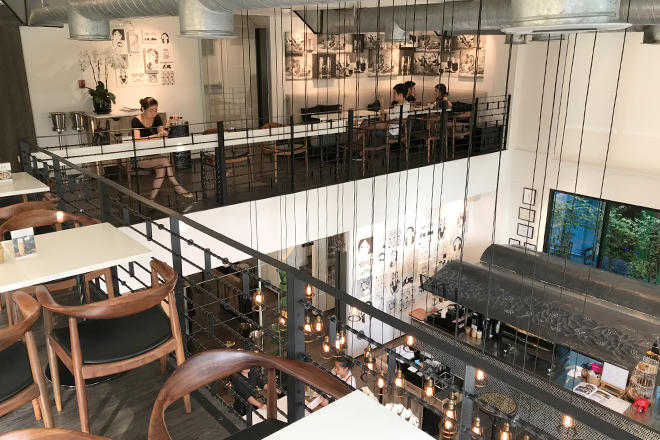
少し話が変わりますが、タイで生活しているととにかく天井が高い空間が多いと感じます。日本は基本的に天井が低いですよね。日本では居室の最低天井高は2.1mと決められており、わたしの実家のバブル全盛期に建てられた集合マンションの天井高も2.1mでした(居室の最低なので、もしかしたら廊下等はもっと低いかもしれない)。それはつまりほんの少しジャンプしただけで天井に触ることができるし、少し背の高い男性ならジャンプなどしなくても手を伸ばしただけで触れられる高さです。
わたしは前職で素敵なオフィス物件を探してご紹介する仕事をしていたのですが、開放感を求めて天井の高さを求める人がとても多いのに対し、天井の高さが3mに達するものはまずないのが日本の現状でした。2.5mあればいい方で、天井が3mもあったらそれだけでかなりの人が殺到する人気物件になります。ただしタイではそんな物件がありふれているので、ほんとうに羨ましい限りです。
普段訪れるショッピングモールやカフェ等も天井が低いと感じる空間はかなり少なく、基本的に天井が高く半吹き抜けになっていて、タイ人の気質にあった開放的な感じになっています。
モノタイの入っている建物について
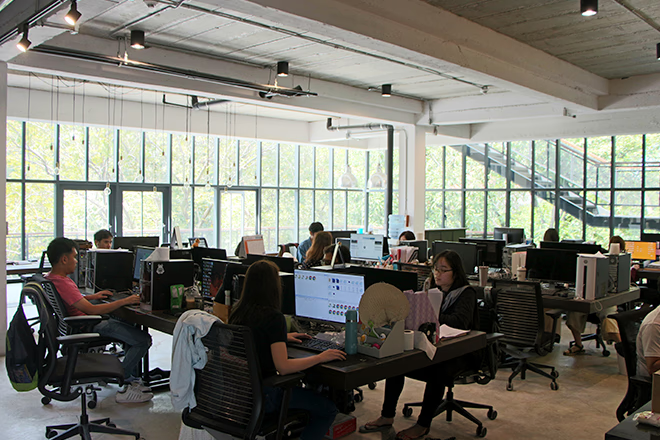
今モノサスタイランドが入っているオフィスは、Naiipa Art Complex という建物内にあります。Naiipaは「森の中」という意味で、オーナー家族が祖父母の代から受け継いだ土地に30〜40年前に家族で植えた木を、全てそのままにしているらしいです。古い木を囲むように建物が設計されているため、どこを見ても緑が目に入ります。オフィスの天井高は3mあり、敷地内の緑が目いっぱいのぞめる大開口です。空間が与える影響はかなり大きく、こんな空間で働いていると、ストレスもたまりにくいように感じます。
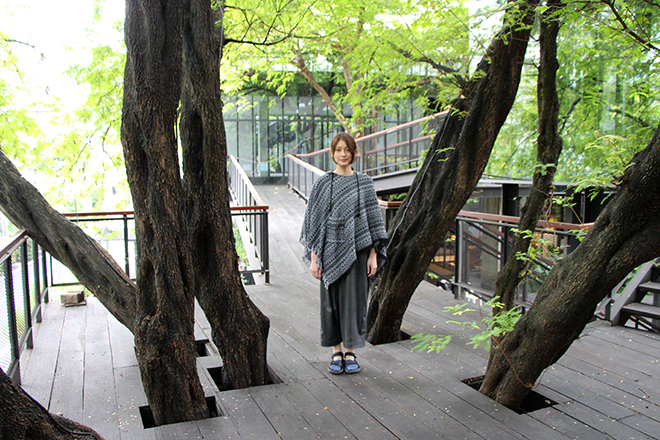
趣のある木をよけて造られているのが分かります
変わってきた? 壁の厚さ
タイに来ることになった当初、はじめての引っ越しと一人暮らしに加え、住む国が変わることで自分を一気に変えられる大きなチャンスだと意気込んでいました。ところが、環境を変えただけでなにかが一気に変わるなんてことはまったくなく、新しい刺激を受けた結果、なにかが自分の中にじわじわと浸透し、自分が変わっていくのにはそれなりに時間がかかるんだなぁと最近ふと思いました。
タイに来て約2年半が経ち、わたしも前より他人との間に感じる壁がすこし薄くなったように感じる今日この頃です。
